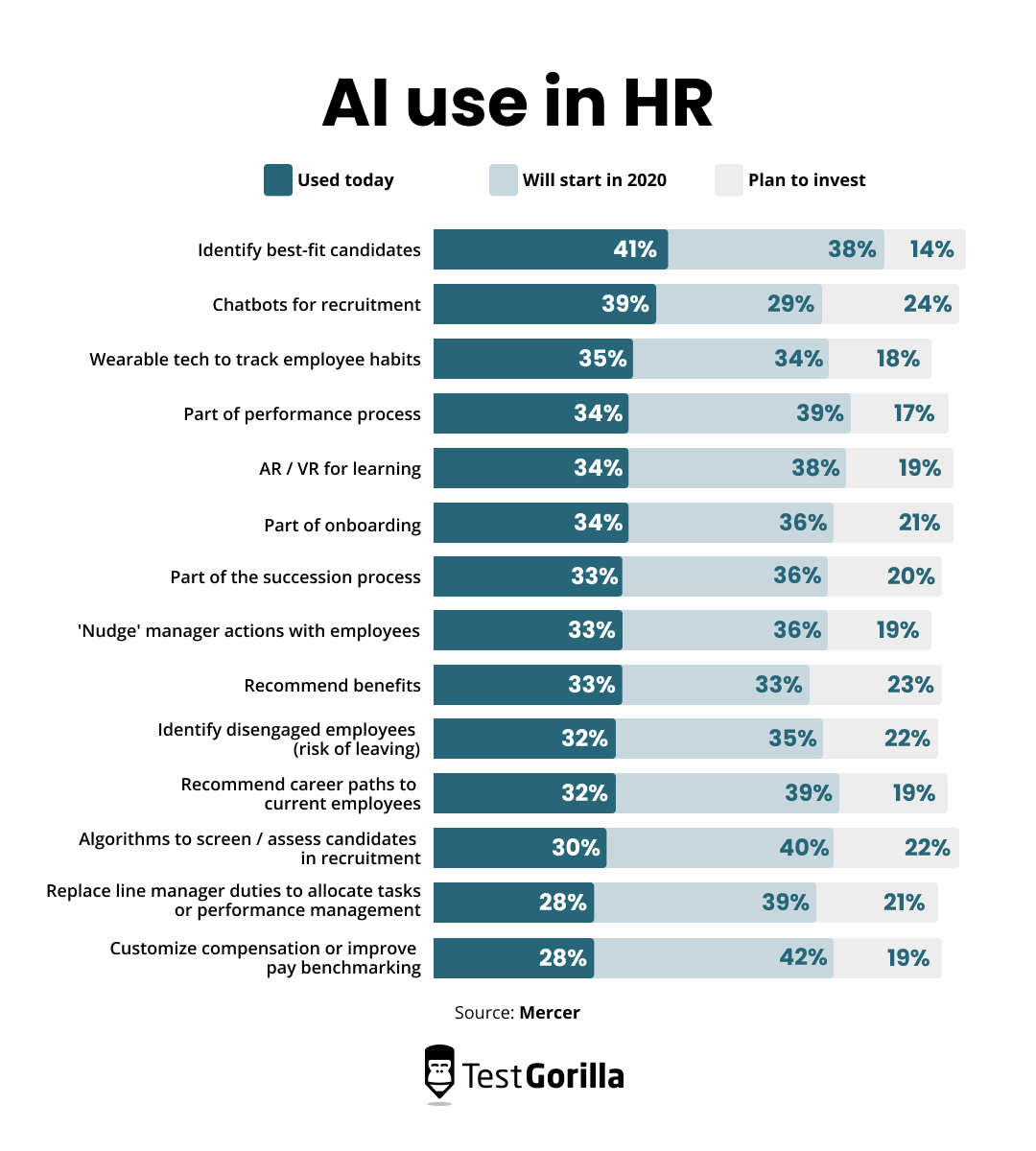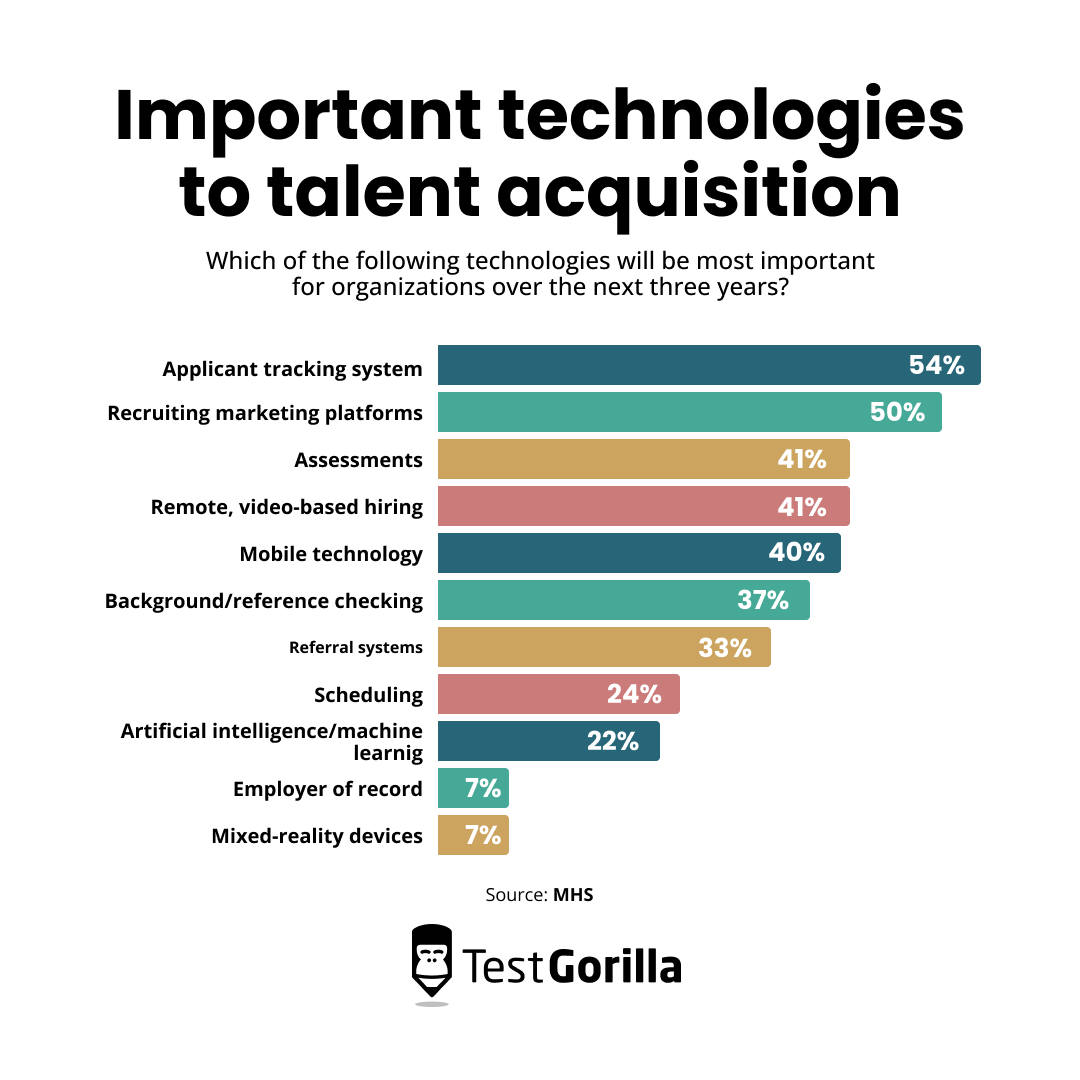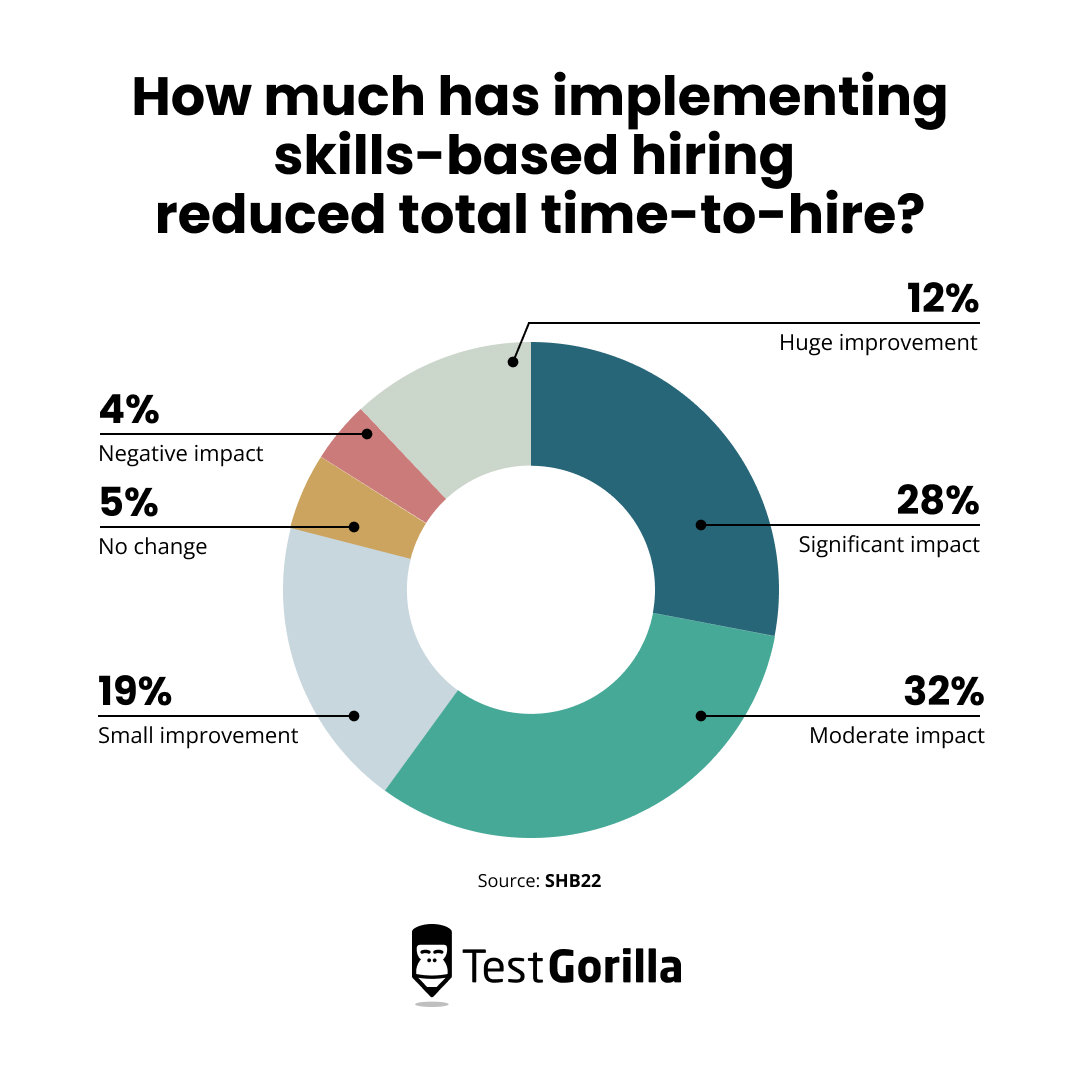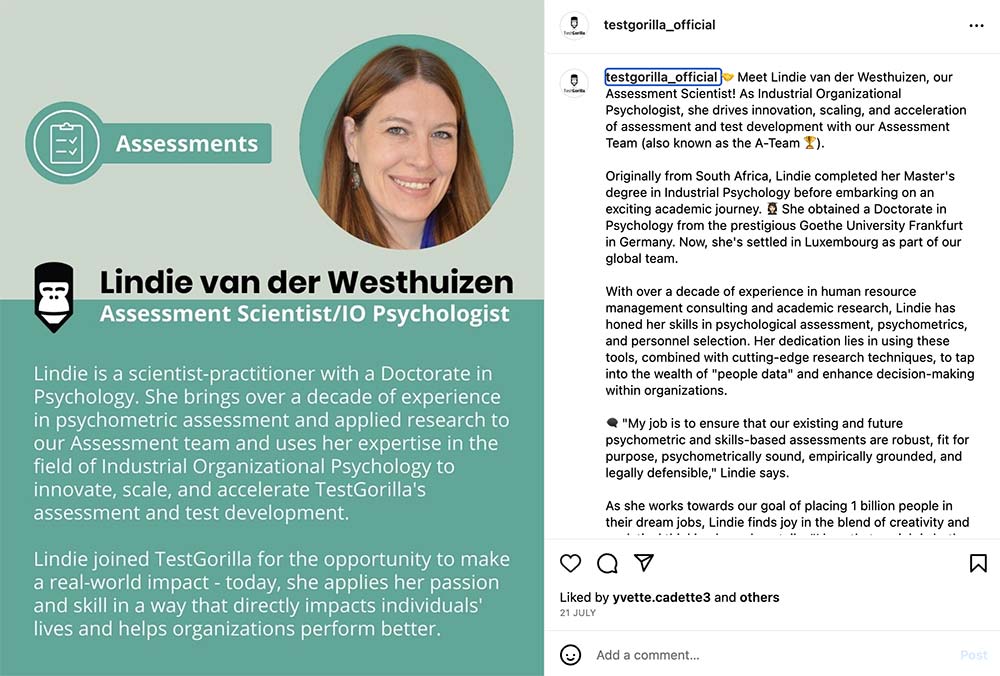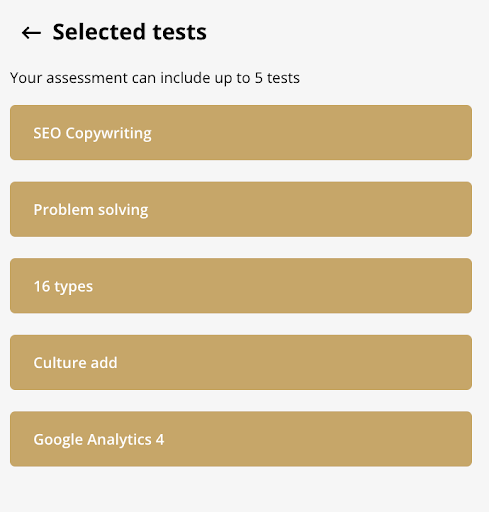Hiring managers who don’t adopt technology risk missing out on top talent.
Companies are increasingly wising up to this, with more than 50% of businesses using artificial intelligence to better match applicants to roles.[1]
Moreover, around 98.8% of companies in the Fortune 500 are using applicant tracking systems (ATS) to help them find the best talent.[2]
This data shows it’s time to embrace high-tech talent acquisition strategies or risk falling behind the pack. Lose pace and risk becoming obsolete.
By using talent acquisition technology effectively, you:
Cut hiring costs
Find candidates with the best skills for the job
Boost HR productivity
Reach more diverse applicants
Enhance the candidates’ experience
This guide examines why talent acquisition tech is a must-have in modern recruiting and how you can use it to your advantage.
Feel free to jump ahead if you want to dive straight into our seven actionable tips.
Table of contents
- What is talent acquisition technology?
- Why is talent acquisition technology important?
- The benefits of talent acquisition technologies
- 7 best practices for using technology in talent acquisition to hire better candidates
- 3 examples of companies succeeding with talent acquisition tech as a talent acquisition strategy
- Use talent acquisition technology and find exceptional people faster
What is talent acquisition technology?
Talent acquisition technology refers to the software and hardware that recruiters use to find, qualify, and manage human resources.
Recruiters use disruptive technology in talent acquisition to:
Aid recruitment marketing across different online channels
Assess candidate suitability, i.e., through skills testing
Manage applicant relationships and track journeys
Automate talent pipelines and outreach campaigns
Conduct remote interviews and meetings
Check references and background details
Building custom technology stacks has become a popular talent acquisition trend, and these usually include different types of software to handle all the recruitment stages.
Types of talent acquisition technology
A talent acquisition tech stack doesn't need to be large or complex; it is usually composed of a set of tools that serve different purposes during recruitment.
Here are a few examples:
Artificial intelligence or AI chatbots
Applicant trackers
Video conferencing and virtual interview platforms
Candidate relationship managers (CRMs)
Scheduling tools
Talent assessments
Social media tools, e.g., Meta Business Suite
Automated candidate sourcing tools
Take your time to research different tools and brands, such as those specializing in online recruitment platforms, because your hiring needs are unique and you might not need all the tools listed above.
Why is talent acquisition technology important?
Using talent acquisition technology is a competitive necessity – businesses improve cost, time, and effort metrics with emerging software and better data insights. Let’s take a closer look.
Importance for employers
Because of increasing candidate numbers, recruiters must prioritize the quality of their human capital. If a company is expanding or there's a revolving-door culture, it's under extra pressure to hire efficiently.
These demands push companies toward data driven recruiting, relying on tangible information to make more efficient, better-informed decisions. Businesses need technology stacks to help source, manage, and analyze data to reap these benefits.
For example, skills testing platforms help recruiters look beyond resume screening for staffing and let candidates prove themselves.
Skills tests deliver objective data that HR can use to measure applicants in different areas – technical aptitude, attention to detail, and leadership qualities.
Another example is applicant tracking systems, which help categorize candidates during the entire hiring process. This also contributes to streamlining and improving hiring plans.
ATS software combines well with talent assessment tools because together they enable recruiters to track skills test results and culture add scores for many candidates and prioritize top-scoring ones.
Importance for employees
People expect a better candidate experience when applying with a tech-positive recruiter.
Tech helps employers better shape recruitment to applicants' individual needs thanks to precise data from social media and chatbots.
For example, an AI chatbot can ask candidates questions and supply answers recruiters then use to better customize interviews.
CRMs also help by ensuring recruiters keep in touch with applicants and advise them about what’s happening at each stage of the hiring process.
This empowers recruiters to move candidates along the hiring pipeline and removes the risk of a slowdown through human error or miscommunication.
The best insights on HR and recruitment, delivered to your inbox.
Biweekly updates. No spam. Unsubscribe any time.
The benefits of talent acquisition technologies
Using talent acquisition technologies helps you:
Stay ahead of the competition
Boost recruitment productivity, efficiency, and performance
Reduce costs
Let’s explore these points more closely.
Stay ahead of the competition
As previously mentioned, companies are increasingly using technology to support recruitment efforts.
For example, up to 43% of HR departments use AI to support recruitment decisions, and candidate profiling and chatbots are the most popular investments:
Building a unique tech stack keeps you ahead of rival recruiters who see the value of emerging technologies. Take a look at some talent acquisition technology trends among HR professionals:
As technology evolves, you have fewer excuses to upgrade your software stack because high-tech tools save businesses time and effort.
Let’s explore that point in a little more detail.
Boost recruitment productivity, efficiency, and performance
The more tasks recruiters delegate to technology, the more time they have to handle the human aspects of recruitment.
Reducing menial tasks for HR staff makes hiring more efficient. Candidates don’t have to wait for the next steps of the recruitment process, and HR can process more applications.
Another great example is that recruitment tech, such as pre-employment testing, reduced time to hire for 91.4% of companies adopting skills-based hiring.
The most accessible recruitment tech also provides users with actionable data through user-friendly platforms.
Recruiters and HR staff feel more confident in their decisions and can create more personalized, engaging experiences for their applicants.
They also have more time for candidate nurturing when they don’t need to handle manual administration – becoming far more productive in their roles.
Reduce costs
Technology helps reduce processing time and costs in some cases, such as in relationship management, data sourcing, and skill qualification.
AI can handle applicant conversations and automate email outreach at different stages of the recruitment process.
As acquisition tech supports data-driven candidate profiling and drives more confident decision-making, you can expect the costs of bad hires to decrease.
As talent quality improves, you’re also reducing the risk of future turnover and the need to run urgent recruitment drives to replace quiet quitters and awkward firings.
Want to get more value from your recruitment?
Our complete blueprint will provide the tips, strategies, and insights you need to maximize your recruitment ROI.
7 best practices for using technology in talent acquisition to hire better candidates
Now that you’ve sampled the benefits of introducing technology into your talent acquisition plan, here are seven ways to use a software stack during recruitment.
How to use talent acquisition tech to upgrade your hiring process
Best practice | How and why |
1. Research and build your tech stack carefully | Establish your process and choose relevant software to keep your hiring efficient, productive, and cost-effective |
2. Consider using artificial intelligence | Use AI to manage repetitive hiring tasks and make recruitment more efficient |
3. Use recruitment automation tools | Automate job listings, skills test requests, and candidate ranking to reduce effort and chances of mis-hiring |
4. Recruit via social media | Build a strong employer branding through popular apps and attract passive candidates |
5. Interview through video | Use video conferencing tools like Zoom to cut down time to hire and appeal to remote and international candidates |
6. Manage candidate relationships with specialized software | Track applications with a CRM from submission to job offer and provide applicants with a clear, efficient, and personalized hiring experience |
7. Remove resumes completely | Use a skills test builder to grade applicants on their talent rather than arbitrary experience and education |
1. Research and build your tech stack carefully
You need various tools to satisfy the different stages of the recruitment process. Take your time to research the different types of acquisition tech available and the leading brands for each type.
Establish your talent acquisition process in separate stages – from initial job listings to application selection.
Consider areas of your process that require the most human intervention for mundane or repetitive tasks, and look for software or tools to help streamline those stages.
And be willing to use different HR technologies to satisfy each process stage.
Not planning your tech stack could confuse HR staff and applicants, making recruitment lengthier and more complex when you want to make things concise and simple for all. Moreover, you could be spending extra on multiple tools for one job.
If you’re unsure which software to use, don’t worry – we explore this in more detail in the steps below.
2. Consider using artificial intelligence
Research into how AI capabilities compare with human intelligence shows it is getting smarter and more efficient every year.
AI data analysis, chat services, and talent pipeline tools have never been more reliable.
Therefore, AI is helping companies scale more efficiently, boost inclusive hiring strategies, and capture complex data that would otherwise take considerable time to source manually.
Just be careful to closely monitor AI in talent acquisition because it still needs human oversight to reduce the risk of bias creeping into its algorithms.
3. Use recruitment automation tools
Recruitment automation reduces human effort and error and cuts time to hire.
At the start of the recruitment process, try using a content automation service to publish job listings and recruitment marketing material across job boards and social media relevant to your hiring roles.
You could prescreen applicants using keyword extraction software, chatbots, and resume parsers to find relevant candidates.
However, you should stop using resumes entirely because it’s more efficient to switch to talent assessments and find the best hires via objective testing.
Instead of prescreening, send talent assessment test links via automated emails to score people in areas relevant to the jobs they’re applying for.
Use these metrics to rank candidates on talent rather than experience, and use software to organize the best prospects before setting interview dates.
4. Recruit via social media
Research shows at least 86% of people looking for work use social media to find ideal opportunities. Recruiting initiatives through socials, therefore, broaden your hiring net and potential talent pool.
Social media recruiting helps you meet candidates via the apps they use daily. What’s more, you appeal to people who dislike the potential spam and phishing they may encounter on job boards and career sites.
Look carefully into the best channels for your ideal candidate profile and take the time to build your employer branding.
Some of the most important content you publish on social channels helps create a sense of who you are and why you’re desirable to work for.
For instance, try publishing “meet the team” profiles:
Building employer branding through social media alongside listing job openings aids passive recruiting. Passive recruits aren’t applying with you during this recruitment drive but might do so later if they're impressed by your brand and company culture.
5. Interview through video
Interviewing via video instead of holding physical meetings opens doors for people of all abilities. Around 86% of companies now choose to interview remotely over in-person.[3]
Video interviews help you appeal to remote employees who can't or prefer not to work in physical offices. Video conferences cut down travel time and costs for applicants and help keep recruitment funnels moving efficiently.
Up to 77% of employees say remote working is the second-most important perk when searching for work.
That means going remote as early as the interviewing stage helps you appeal to most applicants.
Thankfully, it’s not difficult to get started with video interviews. Free video conferencing technology, like Zoom and Microsoft Teams, is accessible across most operating systems and mobile devices.
Using video interviewing platforms over physical meetings helps you reach diverse candidates because you're flexible. You’re more likely to appeal to working parents, students, and disabled people.
If you schedule and account for time zone differences, you can use this strategy to capture more interest when recruiting internationally.
6. Manage candidate relationships with specialized software
CRMs are database tools that keep everyone on the same page, improve candidate experience, and track applications.
You can use a CRM to create a candidate profile when you receive an application or engagement on a social media post. This software completely oversees where your applicants come from and where they are in the recruitment process.
Many CRMs enable you to integrate third-party software, meaning you can attach employment testing and communication channels to track skill scoring and the latest conversations with applicants.
Consider using these recruiting tools with automation to reduce admin and remove guesswork from the next steps in the hiring process. Automation is useful for segmenting candidates into different job roles if you're hiring for several opportunities at any time.
Finally, you can remove the need to search for candidate data and manually list them with a CRM that automatically prioritizes the best people for your roles.
This software is also useful when collaborating with multiple people on projects. Therefore, a talent acquisition team can use the same system and see where specific candidates are in the application process without doubling up on actions like sending emails.
7. Remove resumes completely
Using technology to acquire talent effectively means it’s time to let resumes go.
In most cases, resumes offer little detail about skills and talent and encourage guesswork and unconscious bias.
Removing resumes and as many unnecessary human touch points as possible from the recruiting process helps you base talent acquisition on raw, objective data.
To find whether a recruit is the best add for your company, removing emotion, assumption, and bias is always recommended – they can cloud your judgment.
Adopting a skills-based hiring model with candidate assessment software and talent assessments ensures you only interview the best quality talent and ideal culture adds.
Although some technology helps you assess resumes for prescreening information, skills tests prevent you from falling back into the habit of purely looking at someone's experience.
Resume screening is inefficient for finding ideal candidates. Using technology to assess specific skills and traits keeps your hiring inclusive and diverse.
Consider building a custom assessment plan through a platform like TestGorilla to assess:
Personalities
Culture add potential
Technical aptitude for specific roles.
You can swap these assessments out for different roles as your recruitment needs change. Here's an example of an assessment layout for a marketing copywriter:
Testing these skills lets applicants show you what they can do, regardless of the education they’ve completed and the experience they’ve gained elsewhere.
3 examples of companies succeeding with talent acquisition tech as a talent acquisition strategy
You’re clear on the benefits of using talent acquisition technology and how to get started – so now, let’s check out three examples of companies using tech to enhance their recruiting strategies and attract quality candidates.
Businesses revolutionizing recruitment with talent acquisition technologies
Business example | What the firm does with technology |
Hilton | Interview people without scheduling by asking candidates to record answers when it best suits them |
Newell Brands | Match candidates to highly specific job profiles with an AI-driven talent marketplace |
Magellan Health | Use chatbots to capture applicant data and personalize candidate experience with a tailored CRM |
Hilton
Hilton, the global hotel and hospitality giant, streamlines its interview processes using HireVue, a video conferencing suite.[4]
The suite's "on-demand" interviewing system enables Hilton applicants to sign in and complete interview questions via video whenever suitable.
Prebuilt questions help the hotelier measure all applicants on the same level, and there's zero need to waste time and money scheduling interviews.
HR can then access the prerecorded candidate videos and decide who to move to the next stage in a few short hours.
The technology helped the business interview more applicants while significantly reducing its time to hire.
Newell Brands
Newell Brands, a consumer goods enterprise, uses AI to build career paths based on candidate skills in an "intelligent internal talent marketplace."
The firm initially used an applicant tracking system to build a job board to improve the internal candidate experience. However, this setup proved complex and time-consuming, with staff sifting through thousands of records manually.
Instead, the company adopted an AI-based job matching system, helping to personalize job recommendations for employees looking for internal mobility opportunities.
This move aided in reducing time to hire, improving retention, and increasing internal applications by 129%.[5]
Magellan Health
Magellan Health, a healthcare provider, uses technology to improve the way it connects with candidates.
Like our previous example, the firm adopted AI. But instead of using the technology in a talent marketplace, Magellan Health uses artificial intelligence to streamline applicant conversations using chatbots and a dedicated CRM to connect candidates to recruiters.
This made the company more appealing to candidates by keeping recruiting agile and efficient.
Further benefits for the business include smarter data capture for more personalized experiences and an 86% completion rate for started applications.[6]
Use talent acquisition technology and find exceptional people faster
Mid-to-large companies worldwide use talent acquisition technology to find people who deliver positive, lasting impacts to their brands and customers.
When using tech effectively as a talent acquisition strategy, you:
Streamline your hiring process and reduce time to hire
Cut costs by reducing staff demand
Improve hire quality with insightful, objective data
Stay ahead of the competition
It’s time to upgrade your hiring process – and learning more about recruiting automation is a good way to start.
Then, explore our guide to talent acquisition analytics so you can crunch all your new data and gather actionable insights.
If you’re ready to start skills-testing your prospects, our tests range from the Culture Add test to the International Standards for Auditing test and beyond, so go ahead and give them a try.
P.S. When you’re building your tech stack, you can integrate our assessments with your applicant tracking system and CRM – take a look at our integrations list to learn more.
Sources
“HR’s Future State Report 2021: The Impact of Artificial Intelligence on Talent Processes”. (2021). eightfold.ai. Retrieved September 17, 2023. https://eightfold.ai/wp-content/uploads/HR_Future_State_Report_2021.pdf
Bajaj, Aaina. (February 9, 2023). “How Many Companies Use an ATS [Industry Market Share in 2023]”. GoHire. Retrieved September 17, 2023. https://gohire.io/blog/how-many-companies-use-applicant-tracking
“Gartner HR Survey Shows 86% of Organizations Are Conducting Virtual Interviews to Hire Candidates During Coronavirus Pandemic”. (April 30, 2020). Gartner Newsroom. Retrieved September 17, 2023. https://www.gartner.com/en/newsroom/press-releases/2020-04-30-gartner-hr-survey-shows-86--of-organizations-are-cond
Halzack, Sarah. (February 2, 2014). “At Hilton Worldwide, job interviews are going digital”. The Washington Post. Retrieved September 17, 2023. https://www.washingtonpost.com/business/capitalbusiness/at-hilton-worldwide-job-interviews-are-going-digital/2014/01/31/c3e96308-8775-11e3-916e-e01534b1e132_story.html
“How Newell Brands Is Increasing Employee Retention With an Intelligent Talent Marketplace”. (2022). Phenom Case Study: Newell Brands. Retrieved September 17, 2023. https://9268206.fs1.hubspotusercontent-na1.net/hubfs/9268206/02_Assets/casestudy/221004-EN-CS-NewellBrandsEX2022.pdf
Thomas, Jenn. (November 10, 2020). “How Recruitment Leaders Can Leverage AI to Supercharge the Candidate Experience”. Phenom. Retrieved September 17, 2023. https://www.phenom.com/blog/how-recruitment-leaders-leverage-AI-to-supercharge-the-candidate-experience
You've scrolled this far
Why not try TestGorilla for free, and see what happens when you put skills first.


